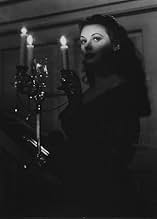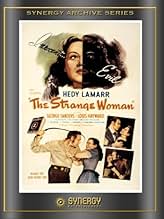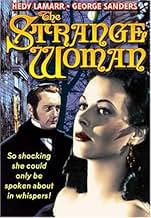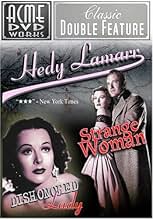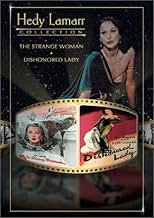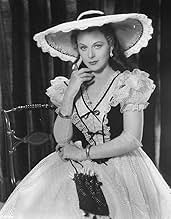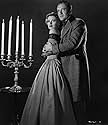Nel 1820, nel New England, Jenny Hager, donna attraente ma povera e manipolatrice, sposa il ricco Isaiah Poster, più vecchio di lei, seducendo anche suo figlio e il caposquadra della sua com... Leggi tuttoNel 1820, nel New England, Jenny Hager, donna attraente ma povera e manipolatrice, sposa il ricco Isaiah Poster, più vecchio di lei, seducendo anche suo figlio e il caposquadra della sua compagnia.Nel 1820, nel New England, Jenny Hager, donna attraente ma povera e manipolatrice, sposa il ricco Isaiah Poster, più vecchio di lei, seducendo anche suo figlio e il caposquadra della sua compagnia.
- Regia
- Sceneggiatura
- Star
- Congregation Member
- (non citato nei titoli originali)
- Congregation Member
- (non citato nei titoli originali)
- Sailor in Saloon
- (non citato nei titoli originali)
- Mrs. Thatcher
- (non citato nei titoli originali)
- Congregation Member
- (non citato nei titoli originali)
- Mr. Partridge
- (non citato nei titoli originali)
Recensioni in evidenza
The film focuses almost exclusively on Jenny and her romantic entanglements, but is also satisfying as a rather odd example of an anachronistic film noir. As such, it is very original in both concept and story. The Strange Woman may be the best piece of directing accomplished by the very prolific B film-maker Edgar Ulmer (Detour). It is nicely shot and paced, and, unlike many noir films, contains a few positive messages in addition to the disturbing stuff.
Recommendation: Serious noir fans will appreciate this, but you have to give this film some time to breathe. It is fairly slow and contains only a few action scenes - which are not its highlights by any stretch. It is also very focused on gender stereotypes (not all of which are treated uncritically), so its appreciation takes a little more thought than the genre standard.
The movie's got the gloss and the casting of a top studio production, maybe TCF. But it's not. Instead, the film is an independent production with Lamarr as a co-producer. I mention this because the result looks tailor-made for a Lamarr career move; at the same time, she does manage to prove she's more than just Hollywood's perfect face. Here, her conniving little vixen (Jenny) transits a number of emotional stages and male victims in fairly convincing style. However, unless I missed something, Jenny's inner guile fails to show up in any of the many close-ups. As a result, Jenny's deceit remains mainly in the script—the one performance flaw.
The movie itself is an atmospheric potboiler, thanks to stylist Edgar Ulmer and art director Remisoff. The scenes may remain stage-bound, but the overall effect is compelling, a triumph of b&w expressiveness. Note too how the scenes get steadily darker as the film progresses and Jenny gets closer to the expected reckoning. Even when the screenplay meanders, which does slow things down, the visuals remain smoothly engaging. Then too, the logging camp setting should have been rethought. The sophisticated Sanders is simply not an outdoor type. Still, wonder of wonders, two of cinema's favorite cerebral baddies, Sanders and Brooke, get sympathetic roles, for a change. Actually, I expected Sanders to break into a cynical sneer at any moment, and maybe Brooke to revert to type with an icy glare. Anyway, it is an interesting cast, down to Hayward as the weakling Ephraim and little Jo Ann Marlowe as the meanest girl since Patty McCormack's Bad Seed (1956).
I don't know if the film resulted in the kind of career break Lamarr was likely looking for, but it remains an entertaining morality tale, despite a spotty script and stage-bound settings.
She is very convincing as the daughter of a drunk who wants to dominate men and the society that squashed her when she was a child. It seems to me that her father speaks with a Scottish burr and that she does very briefly. The story might better have been changed so that he was an immigrant whose accent would be more consistent with th4e luscious Ms. Lamarr's own.
Nevertheless, it is atmospheric and very troubling. She marries an older man and immediately starts out in pursuit of his son. She gets the son and throws him over (a bit improbably) for Gweorge Sanders, wearing mutton chop sideburns here.
It's not Ulmer'best -- that might be his "Hamlet"pdate "Strange Illusion." But it is very good and it is one of the best performances ever given by Ms. Lamarr.
Lo sapevi?
- QuizExecutive producer Hunt Stromberg declared his dissatisfaction with the original opening sequence of Edgar G. Ulmer's own daughter Arianne Ulmer, who played the young Jenny; she purportedly was not nasty enough. So he and Hedy Lamarr enlisted Douglas Sirk to reshoot the scenes using Jo Ann Marlowe, who had appeared in Sirk's Uno scandalo a Parigi (1946) earlier that year, and who also had featured as Joan Crawford's daughter Kay in Michael Curtiz' Il romanzo di Mildred (1945).
- BlooperEphraim paints "Nöel" rather than the correct "Noël".
People often make spelling mistakes, especially where diacritical marks are concerned.
- Citazioni
Lena Tempest: Honey, listen, with your looks you don't have to worry. You can get the youngest and best-looking man on the pier.
Jenny Hager: I don't want the youngest. I want the richest.
- Versioni alternativeVenere peccatrice (1946). Restoration Produced by Jeff Joseph/SabuCat. Digital scan by Film & Video Transfer, Chatsworth, CA. Cineaste Restoration - Thad Komorowski.. Final Conforming & Cleanup by The Finishing Touch. The Strange Woman (Restored Version) copyright 2020 Jeff Joseph/SabuCat.
- ConnessioniFeatured in Edgar G. Ulmer: The Man Off-Screen (2004)
- Colonne sonoreWhat Can You Do with a Drunken Sailor?
Traditional
Early 19th Century sea chanty
[Heard in tavern]
I più visti
- How long is The Strange Woman?Powered by Alexa
Dettagli
- Data di uscita
- Paese di origine
- Siti ufficiali
- Lingua
- Celebre anche come
- Flor de insidia
- Luoghi delle riprese
- Aziende produttrici
- Vedi altri crediti dell’azienda su IMDbPro
- Tempo di esecuzione
- 1h 40min(100 min)
- Colore
- Proporzioni
- 1.37 : 1

